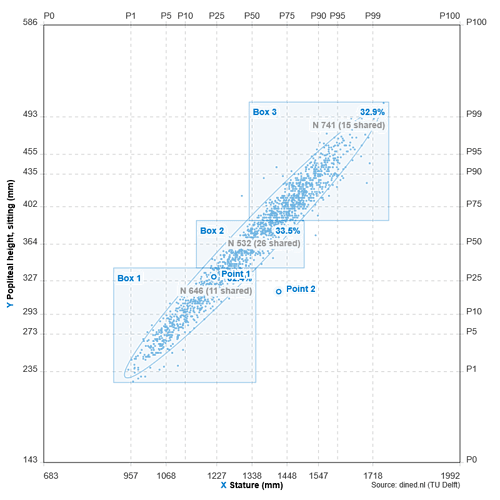DINED Ellips Tool
The Ellips tool was developed to support designers of furniture to analyse how many sizes you would need to accommodate your users.
To prevent too many sizes that need stock in your production hall a producer could say I want only 3 sizes and I want them for an equal number of the population, so each about 33%, because that is easy for the production view point. Below you see the effect. Box2 is much smaller because most children are in there crowded. Also you can read another anthropometric piece of knowledge: if a child has a stature of 1338 mm, the lower leg (popliteal height varies from the bottom side of box 2 to the ceiling of box2 , so about from 33 cm to 38 cm. This way of reading anthropometric data in ELLIPS helps you as a designer to see how the data correlates with each other and how to find how many sizes you need to cover the whole variation.
My comment as an human factors- ergonomics specialist would be:
These sizes will not fit many children. For example in Box 1 there are children with a lower leg length (popliteal height) of 33 cm that have to sit on a seat of 21.5 cm because otherwise the smallest children can’t put their feet on the floor. The feet on the floor should be a starting point. Thereafter you can ask how many children can sit on this seat of 21.5 cm. This will be a small group until there lower legs get longer than +3.5 cm. See below.
To solve this matter I developed the 30 degrees rule: this means a child can sit with the foot on the floor as long the lower leg does not deviate more than 30 degrees from vertical. This rule will result in a lower height (=3,5cm) of Box1. Box2 can be about 4 cm etc. The whole range of seat heights recommended was: 215 (250) 250 (290) 290 (335) 335 (390) 390 (450) 450 (520) 520 (600). For the Dutch Schoolfurniture Standardization Committee we made a proposal based on this calculation and came to 7 different sizes. This knowledge was used in Pren 1729, later evoluated into NEN-EN 1729-1:2015. More about this issue can be read in the following paper:
Revision of the design of a standard for the dimensions of school furniture, Molenbroek JFM, Kroon-Ramaekers YMT, Snijders,C.J.,Ergonomics 46 (7), 681-694 or in Dutch in the book Op Maat Gemaakt, Molenbroek,1994.

